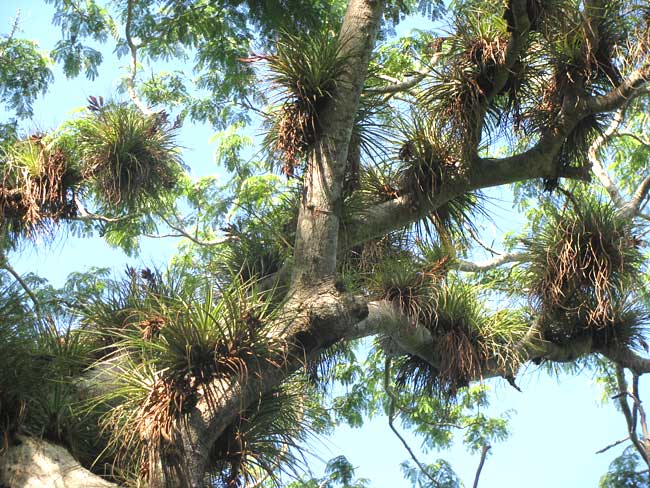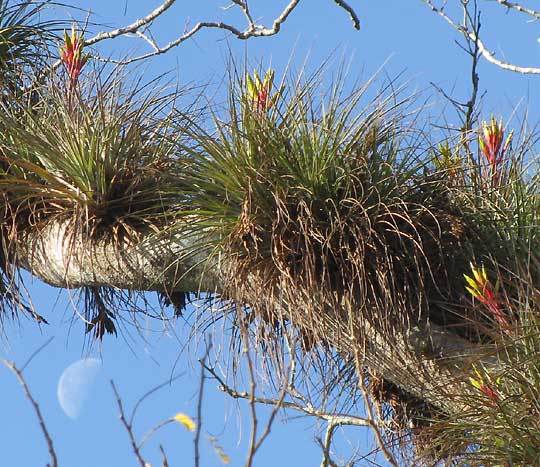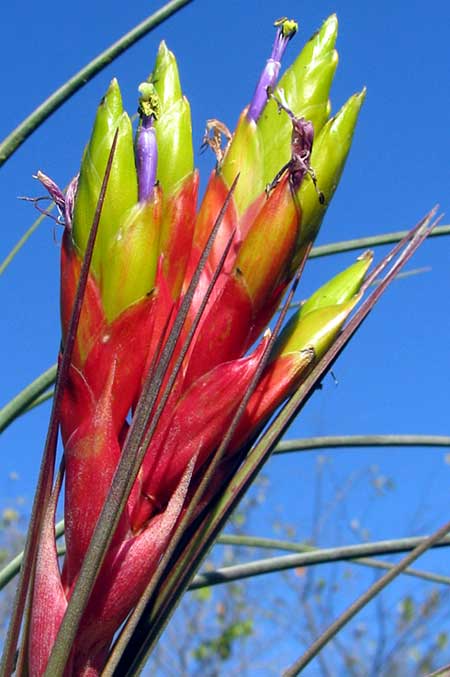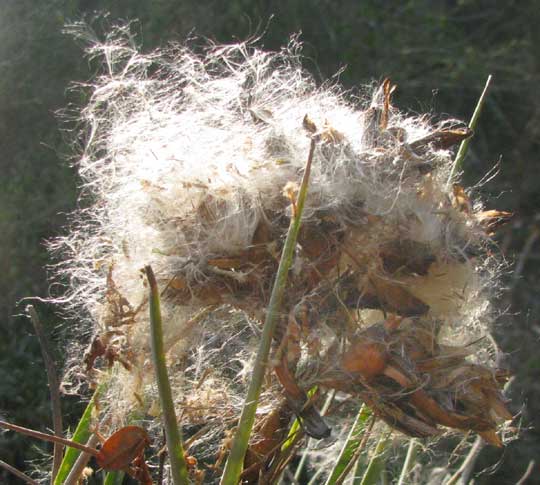Excerpts from Jim Conrad's
Naturalist Newsletter

from the December 13, 2009 Newsletter issued from Hacienda Chichen Resort beside Chichén Itzá Ruins, central Yucatán, MÉXICO; limestone bedrock, elevation ~39m (~128ft), ~N20.676°, ~W88.569°
EPIPHYTES GALORE
The larger trees here often are veritable gardens of epiphytic plants -- plants growing upon other plants. Most conspicuous are the bromeliads, but a good selection of orchids also is present. Unfortunately now at the end of the rainy season this is not the time for most of the species to be blooming, so it's hard to impossible to identify most of what is found. The most common bromeliad, however, still bears fruiting structures, so I think I've figured it out. You can see how the species "grows like a weed" on the massive branches of a big Piich tree here above.
A shot better showing an individual plant is below:

I'm calling this TILLANDSIA FASCICULATA. Luckily the species occurs in southern Florida, so it's well described in the Flora of North America. At least in Florida they call Tillandsia fasciculata the Cardinal Airplant. "Airplant" seems to be a general term used for nearly all bromeliads, while the "Cardinal" part surely is inspired by the plant's red floral bracts. Our plants' bracts are now brown.
One distinctive feature of the species is how the branches of its flowering and fruiting cluster -- its inflorescence -- bunch closely together at the top of the cluster's stem, or peduncle. They almost arise like big, flat fingers from a small hand-palm, so the inflorescence is said to tend toward being "palmate."
The species is abundant here on large trees, but in newer forest that was ranchland maybe 20 years ago typically they are completely absent. They need the moist shelter of a big tree around them.
Bromeliads are not parasitic on their host trees. They simply root on the branches taking nourishment from the air, and debris gathering on the trunks.
from the March 14, 2010 Newsletter issued from Hacienda Chichen Resort beside Chichén Itzá Ruins, central Yucatán, MÉXICO; limestone bedrock, elevation ~39m (~128ft), ~N20.676°, ~W88.569°
TILLANDSIA BROMELIADS FLOWERING
Back in December the conspicuous fruiting heads were dried and brown, and not very attractive. A few weeks ago many plants began issuing fresh, green flowering heads, or inflorescences. Recently the large flower bracts that subtend each flower turned red, and now enough Tillandsia fasciculatas are flowering that hummingbirds spend a lot of time feeding on them. You can see what a nice colony looks like at this stage below:


Above, a close-up of a flowering head shows how individual flowers emerge from their subtending bract. Notice how stamens emerge from violet, tubular corollas. The stamens' stems, or filaments, also are violet colored, but their pollen-shedding anthers are bright yellow. The flowers appear to last only a day or so before wilting, turning brown and falling away, leaving the ovary snugly protected by the wrapping-around bract, as the ovary matures into a fruit.
Tillandsia fasciculata is a very variable species extending from Florida south through Mexico and the West Indies into South America, manifesting itself in seven varieties along he way.
from the April 17, 2011 Newsletter issued from Hacienda Chichen Resort beside Chichén Itzá Ruins, central Yucatán, MÉXICO; limestone bedrock, elevation ~39m (~128ft), ~N20.676°, ~W88.569°
BROMELIADS ISSUING SEEDS
Nowadays many Tillandsia fasciculatas bear mature pods splitting open to release into the wind large numbers of tiny, slender seeds, each seed equipped with white, parachute-like fuzz that helps the wind disseminate the seed into new territory. Sometimes fuzz masses accumulated among the open pods glow intensely when lit from behind by the morning sun, as shown below:

A close-up of some slender, brownish seeds, showing how each seed is topped by fuzz as well as perches atop a white, silky podium, is shown below:

This fuzz configuration is a little different from that of the seeds of Spanish Moss of the US Deep South. Spanish Moss is a member of the same genus as our common bromeliad here -- Spanish Moss being Tillandsia usneoides. You might enjoy comparing Yucatán's Tillandsia fasciculata fuzzy seeds with Spanish Moss's fuzz-footed seeds at www.backyardnature.net/n/h/spanmoss.htm.